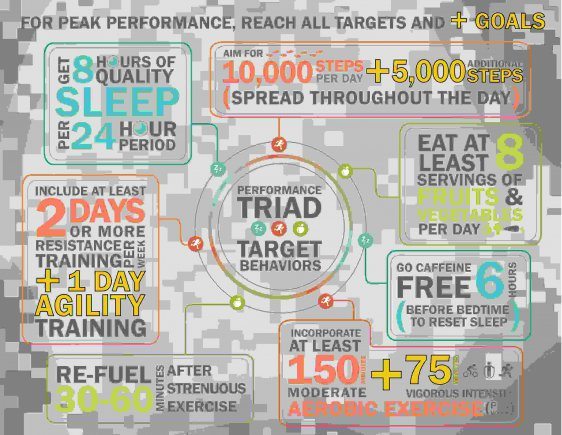It’s time for Soldiers to step it up with the Performance Triad goals. Literally.
During FY 2014, the Performance Triad pilot program was conducted in three separate active-duty battalions. The data from the pilot program provided a picture of the sleep, activity, and nutrition behaviors of Soldiers in the pilot at baseline and throughout the six-month program.
Data collected from the pilot program indicated, however, that some goals needed to be changed for active-duty Soldiers. For example, when surveyed before the pilot program began, 64 percent of Soldiers reported that they were already meeting the activity goals, even before any training or education on the Performance Triad had begun. At the same time, however, only 5 percent of Soldiers were meeting the sleep or nutrition goals.
In short, the sleep and nutrition goals provided Soldiers targets to shoot for; the activity goals were already largely met by most Soldiers. A curious thing happened on the way to the end of the six-month pilot evaluation period; activity levels went backward from exceeding the goals toward only meeting the goals. Soldiers may have unconsciously been reducing their activity to meet the goals they were told to achieve.
The decision was made to update the activity goals for active-duty Soldiers. The updated goals are performance-oriented and based recommendations from professional organizations, including the American College of Sports Medicine, or ACSM, the National Strength and Conditioning Association, and the Army’s physical training policy.
Soldiers should incorporate the following new “plus goals” in the Performance Triad to their routine fitness activities:
- To the requirement for 10,000 steps, 5,000 steps have been added–new total is 15,000 steps
- To the 2-3 days per week goal of resistance training, Soldiers should add one or more day per week of agility training
- To the goal of 150 minutes per week of moderate or greater aerobic exercise, Soldiers should add a “plus goal” of 75 minutes of vigorous exercise.
First, the “plus goal” of 5,000 steps was added after the average number of steps started to decline. Pilot data showed that Soldiers were achieving, on average 11,000 steps per day, and 296 “active minutes” per day at the start of the study. However, during the pilot, the number of steps decreased to an average of 9,600 and the number of active minutes decreased to 254.
The original 10,000-step goal was based on walking 10 minutes every waking hour, a number that is easily met by an active-duty Soldier. Soldiers routinely achieve 4,000-5,000 steps during unit physical training, their goal should be to add an additional 10,000 steps during the day to encourage routine activity and discourage sedentary behavior. The goal of 15,000 steps is more in line with the activity levels of an active-duty Soldier.
Second, in addition to the 2-3 days per week of resistance training, Soldiers should add a “plus goal” of agility training 1 day per week or more. Both the ACSM and the National Strength and Conditioning Association recommend activities that include jumping, landing, explosive movements, sprinting, and obstacle/agility courses. This training is shown to help reduce sports injuries, develop load carrying ability, and increase athletic performance. The updated Performance Triad goal for agility training supports this performance requirement.
Third, in addition to the 150 minutes of moderate or greater aerobic exercise, Soldiers should add a “plus goal” of 75 minutes of vigorous exercise per week. Aerobic activity is classified as “moderate” or “vigorous” based on established objective standards by groups such as ACSM and the World Health Organization. These organizations use a 2:1 ratio for comparing moderate to vigorous activity, so one minute of vigorous activity is equivalent to 2 minutes of moderate activity. Adding this additional goal allows us to provide a recommendation of 300 equivalent minutes of moderate aerobic exercise. From the performance standpoint, vigorous exercise adds improved gains to the individual’s fitness level.
It’s all about reaching and maintaining peak performance. The “plus goals” of the Performance Triad will allow you to step up your active role in improving your health and performance and help Army Medicine become a System for Health.











